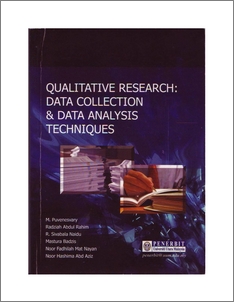Puvenesvary, M. and Abdul Rahim, Radziah and Naidu, R. Sivabala and Badzis, Mastura and Mat Nayan, Noor Fadhilah and Abd Aziz, Noor Hashima
(2008)
Qualitative research : data collection & data analysis techniques.
Universiti Utara Malaysia Press, Sintok.
ISBN 978-983-3827-59-6
![[img]](http://irep.iium.edu.my/style/images/fileicons/application_pdf.png)  Preview |
|
PDF (Qualitative research: data collection & data analysis techniques)
- Published Version
Download (923kB)
| Preview
|
Abstract
This book starts off with Chapter 1 which introduces us to qualitative research, an approach that does not deal with numbers per se, but, has guidelines and a systematic approach within a theoretical framework or design. The chapter also discusses the characteristics of qualitative research; and the differences between qualitative and quantitative research from a philosophical and theoretical perspective. Issues of reliability and validity are also dealt with in connection to the concept of triangulation. Then, how data is analysed is described in detail; and finally, some recommendations on choosing the most suitable software among the many qualitative data analysis software are given.
Chapter 2 takes a look at interview as a viable approach in qualitative research. The popularity of the interview method is perhaps due to the nature of its ‘direct’ verbal interaction between the interviewer or researcher, and the interviewee. The chapters provides the characteristics of a good interview and the stages in carrying out interviews such as pre-interview stage (the selection of respondents/interviewees, selection and sequencing of questions); the actual interview stage; and the post interview stage. Besides this, tips on how to go abut organizing and analysing data are provided. Ethical issues and the reliability and validity of the method are also discussed.
Chapter 3 discusses focus group interviews which is primarily ideal for exploratory types of research and designed for small group situations. This type of research technique allows free flowing conversation, which is informal, candid and captures the respondents’ feelings, attitudes and opinions on the topic or issues being researched on. Essentially, the data collected depends on how successfully the focus group interviews have been conducted and that would depend on a good moderator, i.e. researcher; focused and specific questions and a good facilitator to assist.
Chapter 4 looks at the observational method of study and discusses the different types of observational techniques. As such, the researcher can be part of what us being observed, i.e. a participant observer as opposed to a non-participant observer. It is an excellent method for longitudinal studies in which one is trying to observe changes in behaviour, attitude or the impact of a certain policy/curriculum. However, it can be time-consuming and costly, as well as we may encounter difficulty in documenting data (jotting down or recording) while observing the situation. It can some times be an intrusion and thus, it is very important to find a balance between involvement and detachment; closeness and distance. As such, this method is best for experienced researchers, qualified and trained observers.
Chapter 5 goes into diary studies and discusses the many types of diary studies available, their benefits and weaknesses, as well as steps to carry out a diary studies, and ethical issues at stake. The chapter also talks about diary studies not just being a descriptive account of happenings but rather going beyond this level to be more reflective and critical experience or phenomenon being studies. However, diary studies might not be suitable for some respondents, especially those uncomfortable with the writing mode and being self-critical and reflective. Thus the researcher should ensure that respondents are familiar with the diary studies genre so as to acquire a rich and descriptive data.
Chapter 6 deals with the use of archival documents as another qualitative research tool. The chapter identifies factors that have contributed to the decline I the use of historical evidence; discusses the types of documents that are usually found in archives and provides basic knowledge of how to identify and analyses these documents. It also gives a detailed description of ethical issues involved such as ensuring that the information revealed does not implicate the owners/keepers of the document and clarifying the actual ownership of the data obtained. As with all other methods, archival document have their strengths and weaknesses.
Chapter 7 discusses content analysis as the final method or tool in this book, content analysis is defined as using a set of systematic procedures to make valid inferences about the text which is most suitable for exploratory and descriptive studies. Thus, content analysis would mean not just merely counting or tabulating but rather investigating concepts, semantic relationships and meaning behind the textual surface to look at the lexical choices made. This chapter also looks at the steps in carrying out content analysis, the reliability and validity of content analysis, and its strengths and weakness. It is common and popular method that can be used in a wide range of different genres in communication-from novels and political speeches to the World Wide Web (WWW).
Finally, as a concluding chapter to the book, Chapter 8 explains a crucial aspect of qualitative research-that is, how research reports should be written. Although there is no exact rule or format for writing research reports, the chapter goes through the most common parts which are usually found in a conventional research report-the abstract, table of contents introduction, literature review, methodology, data analysis and discussion. The rationale for each part is explained and suggestions on how to write effectively are also given. Essentially, the parts should be written with clarity and so that the reader/audience understands the report.
Actions (login required)
 |
View Item |


 Download Statistics
Download Statistics Download Statistics
Download Statistics